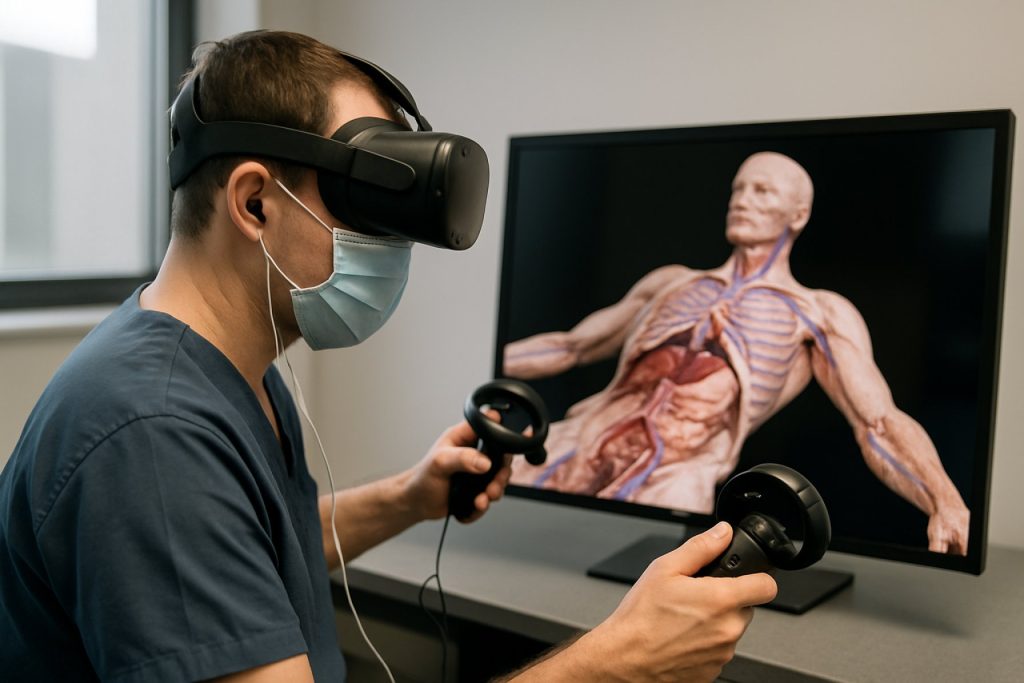
Virtual Anatomical Simulation Platforms in 2025: Transforming Healthcare Education, Surgical Planning, and Patient Outcomes. Explore the Technologies, Market Growth, and Future Disruptions Shaping the Next Five Years.
- Executive Summary: Key Trends and Market Drivers in 2025
- Market Size, Growth Rate, and Forecasts Through 2030
- Core Technologies: 3D Modeling, VR/AR, and AI Integration
- Leading Companies and Platform Innovations (e.g., 3D Systems, CAE Healthcare, Anatomage)
- Applications: Medical Education, Surgical Planning, and Patient-Specific Simulation
- Regulatory Landscape and Industry Standards (e.g., fda.gov, ieee.org)
- Regional Analysis: North America, Europe, Asia-Pacific, and Emerging Markets
- Competitive Landscape and Strategic Partnerships
- Challenges: Data Security, Interoperability, and Adoption Barriers
- Future Outlook: Disruptive Trends and Opportunities for 2025–2030
- Sources & References
Executive Summary: Key Trends and Market Drivers in 2025
Virtual anatomical simulation platforms are rapidly transforming medical education, surgical planning, and clinical training as we enter 2025. These platforms leverage advanced 3D modeling, artificial intelligence (AI), and immersive technologies such as virtual reality (VR) and augmented reality (AR) to provide highly detailed, interactive representations of human anatomy. The convergence of these technologies is driving a paradigm shift in how healthcare professionals acquire and refine their skills, with significant implications for patient safety, procedural efficiency, and global access to high-quality training.
A key trend in 2025 is the widespread adoption of VR- and AR-based simulation platforms in medical schools and teaching hospitals. Companies like 3D Systems and Stryker are at the forefront, offering platforms such as Simbionix and the Mako system, respectively, which enable realistic, hands-on practice of complex procedures. 3D Systems continues to expand its portfolio with cloud-based solutions, allowing remote access and collaborative learning, a feature that has become increasingly important in the wake of global disruptions to in-person education.
Another major driver is the integration of AI-powered analytics into simulation platforms. These tools provide real-time feedback and performance assessment, enabling personalized learning pathways and objective skill evaluation. Intuitive, known for its da Vinci surgical systems, is investing in simulation modules that use AI to track user performance and suggest targeted improvements. This data-driven approach is expected to accelerate competency-based training and certification processes.
The demand for scalable, cost-effective training solutions is also fueling innovation. Medtronic and Mentice are developing cloud-enabled platforms that support remote instruction and global collaboration, addressing the shortage of skilled trainers and the need for standardized curricula across regions. These platforms are increasingly being adopted in emerging markets, where access to cadaveric training is limited.
Looking ahead, the next few years will likely see further convergence of simulation platforms with real-time patient data, enabling personalized rehearsal of procedures based on individual anatomy. Regulatory bodies and professional societies are expected to formalize the role of virtual simulation in certification and continuing education, further cementing its place in the healthcare ecosystem. As hardware costs decline and software capabilities expand, virtual anatomical simulation platforms are poised to become a standard component of medical training and practice worldwide.
Market Size, Growth Rate, and Forecasts Through 2030
The market for virtual anatomical simulation platforms is experiencing robust growth, driven by the increasing adoption of digital tools in medical education, surgical planning, and healthcare training. As of 2025, the sector is characterized by rapid technological advancements, expanding user bases, and significant investments from both established medical device companies and innovative startups. The global market size for virtual anatomical simulation platforms is estimated to surpass several billion USD by 2025, with compound annual growth rates (CAGR) projected in the low to mid-teens through 2030.
Key players in this space include 3D Systems, whose Simbionix line offers a range of virtual reality (VR) and augmented reality (AR) simulators for surgical training and preoperative planning. Stratasys is also active in the field, leveraging its expertise in 3D printing and digital modeling to support anatomical education and simulation. Mentice specializes in endovascular simulation platforms, serving hospitals and medical device companies worldwide. OSSIMTech and Touch Surgery (by Medtronic) are further notable for their focus on immersive, cloud-based, and mobile-accessible simulation solutions.
The growth trajectory is underpinned by several factors. Medical schools and teaching hospitals are increasingly integrating virtual simulation into curricula to address the limitations of cadaver-based training and to provide scalable, repeatable, and safe learning environments. The COVID-19 pandemic accelerated this trend, highlighting the need for remote and flexible educational tools. Additionally, regulatory bodies and accreditation organizations are recognizing the value of simulation-based competency assessments, further driving institutional adoption.
Regionally, North America and Europe currently lead in market share, owing to advanced healthcare infrastructure and early technology adoption. However, Asia-Pacific is expected to witness the fastest growth through 2030, fueled by expanding medical education sectors and government initiatives to modernize healthcare training.
Looking ahead, the market is poised for continued expansion as simulation platforms become more sophisticated, incorporating artificial intelligence, haptic feedback, and real-time performance analytics. Strategic partnerships between platform developers, medical device manufacturers, and academic institutions are expected to accelerate innovation and broaden access. By 2030, virtual anatomical simulation platforms are anticipated to become a standard component of medical education and clinical practice worldwide, with leading companies such as 3D Systems, Stratasys, and Mentice continuing to shape the competitive landscape.
Core Technologies: 3D Modeling, VR/AR, and AI Integration
Virtual anatomical simulation platforms are rapidly transforming medical education and clinical training, leveraging advances in 3D modeling, virtual reality (VR), augmented reality (AR), and artificial intelligence (AI). As of 2025, these core technologies are converging to deliver highly realistic, interactive, and adaptive learning environments that surpass traditional cadaver-based or textbook approaches.
At the heart of these platforms is sophisticated 3D anatomical modeling. Companies such as 3D4Medical (now part of Elsevier) have set industry standards with their detailed, high-resolution anatomical models, which are continually updated to reflect the latest medical knowledge. These models form the basis for immersive VR and AR experiences, allowing users to explore, dissect, and manipulate anatomical structures in real time. Visible Body is another key player, offering comprehensive 3D anatomy visualization tools widely adopted by medical schools and healthcare institutions globally.
The integration of VR and AR technologies has accelerated in recent years, with platforms such as Osso VR and Medivis providing fully immersive surgical simulations and anatomy education. These systems utilize advanced headsets and haptic feedback devices to replicate the tactile and spatial aspects of real-world procedures. In 2024 and 2025, the adoption of wireless, high-resolution VR headsets and lightweight AR glasses is expected to further enhance accessibility and realism, enabling more widespread use in both academic and clinical settings.
AI integration is a defining trend for 2025 and beyond. Leading platforms are embedding AI-driven adaptive learning algorithms that personalize content and assessment based on individual user performance. For example, ImmersiveTouch employs AI to analyze user interactions and provide targeted feedback, optimizing skill acquisition and retention. Additionally, AI-powered anatomical segmentation and real-time rendering are enabling more accurate and efficient creation of patient-specific models, supporting both education and preoperative planning.
Looking ahead, the next few years will likely see further convergence of these technologies, with cloud-based collaboration, real-time multi-user environments, and integration with electronic health records (EHRs) on the horizon. Industry leaders such as 3D4Medical, Visible Body, Osso VR, and Medivis are poised to drive innovation, making virtual anatomical simulation platforms an indispensable component of modern medical education and practice.
Leading Companies and Platform Innovations (e.g., 3D Systems, CAE Healthcare, Anatomage)
The virtual anatomical simulation platform sector is experiencing rapid innovation and expansion in 2025, driven by the convergence of advanced visualization technologies, artificial intelligence, and increasing demand for remote and immersive medical education. Several leading companies are shaping the landscape with their proprietary platforms and ongoing R&D investments.
3D Systems remains a pivotal player, leveraging its expertise in 3D printing and digital modeling to deliver comprehensive simulation solutions. Its Simbionix line offers a suite of virtual reality (VR) simulators for surgical training, including modules for endovascular, laparoscopic, and robotic procedures. The company continues to enhance realism and interactivity, integrating haptic feedback and cloud-based performance analytics to support both individual learners and institutional programs. In 2025, 3D Systems is expanding its partnerships with medical schools and hospitals globally, aiming to standardize simulation-based competency assessment (3D Systems).
CAE Healthcare, a division of CAE Inc., is recognized for its high-fidelity simulation platforms that blend virtual and physical modalities. Its CAE Vimedix and CAE Maestro platforms provide anatomically accurate, interactive environments for ultrasound, echocardiography, and emergency medicine training. In 2025, CAE Healthcare is focusing on AI-driven scenario generation and real-time performance feedback, enabling adaptive learning pathways. The company is also advancing remote simulation capabilities, allowing distributed teams to collaborate in shared virtual spaces—a response to the growing need for flexible, scalable training solutions (CAE Inc.).
Anatomage is renowned for its Anatomage Table, a life-sized, touch-interactive virtual dissection platform used in medical schools and research institutions worldwide. The latest generation, released in 2025, features ultra-high-resolution 3D scans, expanded pathology libraries, and integration with augmented reality (AR) headsets for enhanced spatial understanding. Anatomage is also investing in cloud-based content sharing, enabling educators to create and distribute custom case studies and anatomical datasets across institutions (Anatomage).
Other notable innovators include VirtaMed, which specializes in mixed-reality simulators for minimally invasive procedures, and Mentice, focusing on endovascular simulation with advanced physiological modeling. Both companies are expanding their platform ecosystems in 2025, emphasizing interoperability with electronic health records and surgical robots (VirtaMed; Mentice).
Looking ahead, the sector is expected to see further integration of AI, cloud collaboration, and extended reality (XR) technologies, with leading companies driving the adoption of virtual anatomical simulation as a core component of medical education and clinical skills development.
Applications: Medical Education, Surgical Planning, and Patient-Specific Simulation
Virtual anatomical simulation platforms are rapidly transforming the landscape of medical education, surgical planning, and patient-specific simulation as of 2025. These platforms leverage advanced 3D modeling, artificial intelligence, and immersive technologies such as virtual reality (VR) and augmented reality (AR) to create highly detailed, interactive representations of human anatomy. Their adoption is accelerating across academic institutions, hospitals, and surgical training centers worldwide.
In medical education, virtual simulation platforms are increasingly replacing traditional cadaver-based training. Solutions like 3D Systems‘s Simbionix and OSSIMTech offer comprehensive modules for anatomy learning, procedural training, and skills assessment. These platforms provide repeatable, risk-free environments for students to practice complex procedures, improving knowledge retention and technical proficiency. The integration of haptic feedback and real-time performance analytics further enhances the learning experience, making it possible to tailor instruction to individual needs.
For surgical planning, virtual anatomical simulation platforms enable clinicians to visualize patient-specific anatomy using data from CT, MRI, or ultrasound scans. Companies such as Stryker and Siemens Healthineers have developed advanced software that allows surgeons to rehearse procedures on digital twins of their patients, anticipate challenges, and optimize surgical approaches. This capability is particularly valuable in complex cases such as neurosurgery, orthopedics, and cardiovascular interventions, where precision is critical. The use of these platforms has been associated with reduced operative times, fewer complications, and improved patient outcomes.
- Patient-specific simulation is gaining momentum as a tool for personalized medicine. Platforms like VirtaMed and Medtronic are enabling clinicians to create customized simulations based on individual patient data, facilitating preoperative planning and patient education. This approach not only enhances surgical accuracy but also improves patient engagement and informed consent.
- Outlook for 2025 and beyond: The next few years are expected to see further integration of AI-driven analytics, cloud-based collaboration, and real-time remote simulation capabilities. Partnerships between technology providers and healthcare institutions are likely to expand, driving broader adoption and continuous innovation. As regulatory bodies increasingly recognize the value of simulation-based training and planning, virtual anatomical platforms are poised to become standard tools in both education and clinical practice.
Regulatory Landscape and Industry Standards (e.g., fda.gov, ieee.org)
The regulatory landscape for virtual anatomical simulation platforms is rapidly evolving as these technologies become increasingly integral to medical education, surgical planning, and device development. In 2025, regulatory agencies and standards organizations are intensifying their focus on ensuring the safety, efficacy, and interoperability of these platforms, reflecting their growing adoption in clinical and academic settings.
In the United States, the U.S. Food and Drug Administration (FDA) has continued to refine its approach to digital health technologies, including virtual simulation tools. The FDA’s Digital Health Center of Excellence is actively engaging with developers of simulation platforms to clarify regulatory pathways, particularly for products intended for clinical decision support or preoperative planning. The FDA’s Software as a Medical Device (SaMD) framework is increasingly relevant, with simulation platforms that influence clinical care falling under regulatory scrutiny. In 2024 and 2025, the FDA has issued updated guidance on the validation and verification of simulation software, emphasizing transparency in model assumptions, data provenance, and performance metrics.
Globally, the European Medicines Agency (EMA) and other regulatory bodies are aligning with international standards for digital health. The International Medical Device Regulators Forum (IMDRF) continues to harmonize requirements for software-based medical devices, including simulation platforms, to facilitate cross-border adoption and streamline approvals.
Industry standards are also advancing. The IEEE has ongoing initiatives to standardize data formats, interoperability protocols, and performance benchmarks for medical simulation systems. The IEEE 11073 family of standards, traditionally focused on medical device communication, is being extended to encompass virtual and augmented reality platforms, ensuring seamless integration with hospital information systems and electronic health records.
Leading industry players such as Dassault Systèmes (developer of the Living Heart Project and SIMULIA), Stratasys (with its Digital Anatomy solutions), and Medtronic (which incorporates simulation in device development and training) are actively participating in standards development and regulatory consultations. These companies are collaborating with regulatory agencies to establish best practices for model validation, user training, and cybersecurity.
Looking ahead, the next few years are expected to bring further regulatory clarity, with more explicit requirements for clinical validation, real-world performance monitoring, and post-market surveillance of virtual anatomical simulation platforms. As adoption accelerates, industry and regulators are likely to converge on robust frameworks that balance innovation with patient safety and data integrity.
Regional Analysis: North America, Europe, Asia-Pacific, and Emerging Markets
The global landscape for virtual anatomical simulation platforms is rapidly evolving, with distinct regional trends shaping adoption and innovation. In North America, the United States remains at the forefront, driven by robust investments in medical education technology and a strong presence of leading developers. Companies such as 3D Systems and CAE Healthcare are expanding their simulation portfolios, integrating advanced haptic feedback and AI-driven anatomical modeling. The region benefits from close collaboration between academic medical centers and technology firms, with regulatory support from agencies like the FDA accelerating clinical validation and deployment. Canada is also witnessing increased adoption, particularly in university medical curricula and surgical training programs.
In Europe, the market is characterized by a strong emphasis on standardized medical training and cross-border research initiatives. Companies such as VirtaMed (Switzerland) and Laparo (Poland) are prominent, offering platforms that support both basic and advanced procedural simulations. The European Union’s focus on digital health transformation and funding for simulation-based education is expected to drive further growth through 2025 and beyond. The United Kingdom, Germany, and France are leading adopters, with national health systems increasingly integrating virtual simulation into continuing professional development for clinicians.
The Asia-Pacific region is experiencing rapid expansion, fueled by growing healthcare infrastructure investments and a rising demand for skilled medical professionals. Japan and South Korea are notable for their early adoption of high-fidelity simulation, with companies like Kyoto Kagaku providing anatomically accurate virtual and hybrid simulators. In China, government initiatives to modernize medical education are spurring partnerships between universities and technology providers, while Australia is investing in simulation centers to address rural healthcare training needs. The region is expected to see the highest compound annual growth rate (CAGR) in the next few years, as local manufacturers and international players expand their presence.
In emerging markets, particularly in Latin America, the Middle East, and parts of Africa, adoption is at an earlier stage but gaining momentum. Local distributors are increasingly partnering with global leaders such as Laerdal Medical to introduce cost-effective virtual simulation solutions. These regions face challenges related to infrastructure and funding, but international aid programs and public-private partnerships are helping to bridge the gap. As internet connectivity and digital literacy improve, virtual anatomical simulation platforms are expected to play a crucial role in scaling medical education and improving patient outcomes in these markets through 2025 and beyond.
Competitive Landscape and Strategic Partnerships
The competitive landscape for virtual anatomical simulation platforms in 2025 is characterized by rapid technological innovation, strategic alliances, and a growing emphasis on global market expansion. Leading companies are leveraging advanced visualization, artificial intelligence, and cloud-based delivery to enhance the realism and accessibility of anatomical simulations for medical education, surgical planning, and patient engagement.
Key players such as 3D Systems, Stratasys, and ImmersiveTouch continue to invest in R&D to refine their simulation platforms. 3D Systems has expanded its portfolio with cloud-enabled modules and AI-driven anatomical modeling, targeting both academic institutions and hospital networks. Stratasys integrates its 3D printing expertise with digital simulation, offering hybrid solutions that bridge virtual and physical anatomical models for comprehensive training experiences.
Strategic partnerships are a defining feature of the sector. In recent years, collaborations between simulation technology providers and medical device manufacturers have accelerated. For example, ImmersiveTouch has partnered with leading hospitals to co-develop patient-specific surgical rehearsal platforms, while 3D Systems has established alliances with academic medical centers to integrate simulation into curricula and certification programs. These partnerships not only drive product innovation but also facilitate regulatory acceptance and clinical validation.
Emerging entrants such as OSSIMTech and VirtaMed are gaining traction by focusing on specialized simulation modules, such as orthopedic and endoscopic procedures, and by offering scalable, cloud-based solutions for remote and distributed learning environments. VirtaMed in particular has expanded its global footprint through collaborations with medical societies and device companies, aiming to standardize simulation-based training across regions.
Looking ahead, the competitive landscape is expected to intensify as more healthcare systems mandate simulation-based training and as regulatory bodies increasingly recognize virtual simulation for credentialing. Companies are likely to pursue further strategic partnerships, including with AI developers and telemedicine providers, to enhance platform capabilities and reach. The next few years will also see increased interoperability between simulation platforms and electronic health records, supporting personalized medicine and data-driven education.
Challenges: Data Security, Interoperability, and Adoption Barriers
Virtual anatomical simulation platforms are rapidly transforming medical education, surgical planning, and device development. However, as these platforms become more sophisticated and widely adopted in 2025, several critical challenges persist—particularly in the areas of data security, interoperability, and user adoption.
Data Security: The integration of patient-specific imaging data and sensitive health information into simulation platforms raises significant concerns about privacy and cybersecurity. As these platforms often rely on cloud-based infrastructure and real-time data exchange, they become potential targets for cyberattacks. Leading providers such as 3D Systems and Stratasys are investing in advanced encryption protocols and compliance with international standards like HIPAA and GDPR. Nevertheless, the increasing sophistication of cyber threats in 2025 means that maintaining robust security measures is an ongoing challenge, especially as platforms expand to support remote and collaborative simulations.
Interoperability: The virtual simulation ecosystem is fragmented, with platforms often using proprietary file formats and data standards. This lack of interoperability hinders seamless integration with hospital information systems, imaging modalities, and other digital health tools. Companies such as Materialise are working to address this by supporting open standards (e.g., DICOM for medical imaging), but widespread compatibility remains elusive. The challenge is compounded as new entrants and established players introduce unique features and workflows, making it difficult for institutions to adopt a unified approach. Industry bodies are pushing for greater standardization, but progress is incremental and requires broad collaboration.
Adoption Barriers: Despite the clear benefits of virtual anatomical simulation, adoption is uneven across regions and institutions. High upfront costs for software licenses, hardware (such as VR/AR headsets), and training remain significant obstacles, particularly for smaller hospitals and educational institutions. Additionally, there is a learning curve for clinicians and educators unfamiliar with digital simulation tools. Companies like OSSIMTech and Surgical Science are expanding their training and support services to facilitate smoother onboarding, but cultural resistance and budget constraints persist. In 2025, the sector is also grappling with the need to demonstrate clear clinical and educational outcomes to justify investment, as healthcare systems face increasing financial pressures.
Looking ahead, overcoming these challenges will require coordinated efforts among technology providers, healthcare institutions, and regulatory bodies. Advances in secure data exchange, open standards, and cost-effective deployment models are expected to gradually reduce barriers, but the pace of progress will depend on sustained investment and cross-sector collaboration.
Future Outlook: Disruptive Trends and Opportunities for 2025–2030
The period from 2025 to 2030 is poised to witness significant advancements in virtual anatomical simulation platforms, driven by rapid improvements in computing power, artificial intelligence, and immersive technologies. These platforms, which enable detailed, interactive exploration of human anatomy in virtual environments, are increasingly being adopted in medical education, surgical planning, and patient engagement.
A key trend is the integration of real-time artificial intelligence (AI) to enhance anatomical realism and interactivity. Companies such as 3D Systems are leveraging AI to generate highly accurate, patient-specific anatomical models, which can be manipulated in virtual reality (VR) or augmented reality (AR) settings. This allows for more personalized surgical rehearsal and education, reducing the reliance on cadavers and physical models. Similarly, ImmersiveTouch is advancing haptic feedback and cloud-based collaboration, enabling remote teams to interact with the same virtual anatomy in real time.
The adoption of extended reality (XR) is expected to accelerate, with platforms like Medicalholodeck and OSSIMTech offering multi-user, cross-platform environments for medical training and simulation. These solutions are increasingly compatible with a range of hardware, from high-end VR headsets to portable AR devices, making them accessible to a broader user base. The trend towards interoperability and open standards is also gaining momentum, as industry bodies and companies collaborate to ensure seamless integration with hospital information systems and imaging modalities.
Data from leading manufacturers indicate a growing demand for cloud-based simulation, which allows for scalable deployment and continuous updates. 3D4Medical, known for its Complete Anatomy platform, is expanding its offerings to include collaborative features and AI-driven assessment tools, supporting both individual and group learning. The shift towards subscription-based models is expected to lower barriers to entry for educational institutions and healthcare providers, further driving adoption.
Looking ahead, the convergence of virtual anatomical simulation with digital twins and predictive analytics is anticipated to open new frontiers in personalized medicine. By 2030, it is likely that these platforms will be integral to preoperative planning, patient-specific device design, and even remote diagnostics. As regulatory frameworks evolve to accommodate virtual simulation in clinical workflows, the sector is set for robust growth, with opportunities for innovation in content creation, user experience, and data security.
Sources & References
- 3D Systems
- Intuitive
- Medtronic
- Mentice
- Stratasys
- 3D4Medical
- Visible Body
- Medivis
- VirtaMed
- Siemens Healthineers
- European Medicines Agency
- IEEE
- Kyoto Kagaku
- Laerdal Medical
- Materialise
- Surgical Science
- Medicalholodeck



